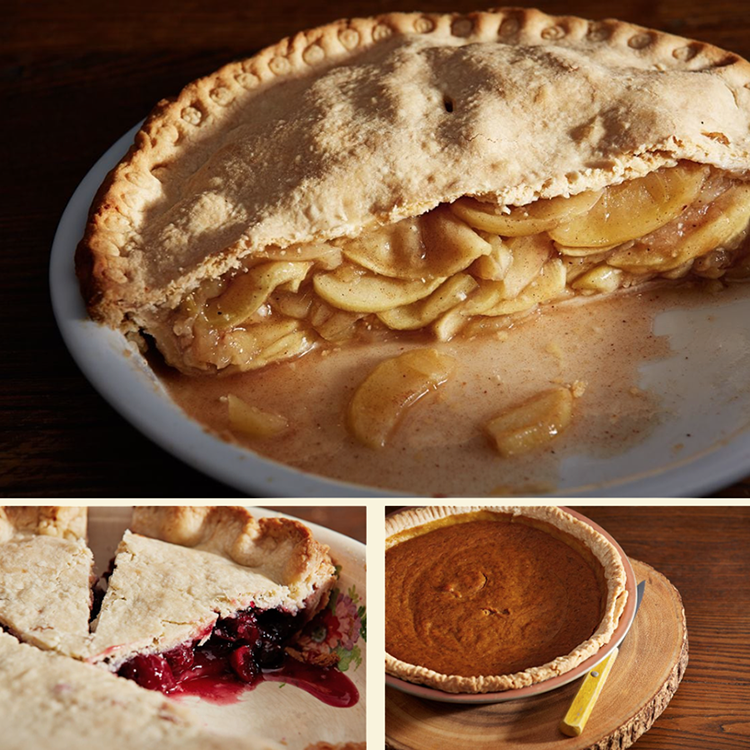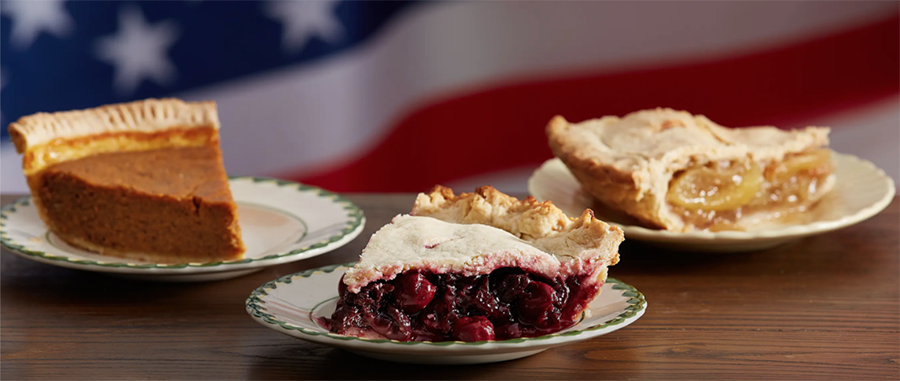Americans invented the dessert we call pie. Why are we letting it die?
||| FROM WASHINGTON POST |||
I grew up in a home in which pie was spoken fluently. As a child, I assumed that pie appeared on everyone’s table, as it did year-round on mine. Looking back, I seem not so much to have traveled the circle of the sun as it inched through the seasons but around the rim of a pie tin: Lemon meringue to sour cherry, sour cherry to purple raspberry, purple raspberry to peach, then onward to apple and, finally, to holiday pumpkin and pecan.
It was only when I left home that I realized how unusual it was to have a mother and grandmother who tossed off perfect pies the way some people drop witty epigrams — and how borderline miraculous their pie crusts were.
For a lot of people, pie is all about the filling; the crust is an afterthought. Without the crust, though, you are eating a mousse, a custard or a compote — delicious all, but distinctly not pie. And if you are going to encase those excellent things in a flaccid flap of flavorless pastry, why not skip the extra calories and make only the good part?
So a pie worthy of the name must have a good crust — not just a vehicle for filling but a delight in itself. It marries tenderness with flakiness. It’s delicate, yet strong enough to keep the filling where it belongs. It’s nothing like the tough, desiccated things that most people mean when they say “pie crust.”
That’s not exactly their fault, because probably most of those crusts are store-bought. In 2019, more than 50 million Americans used frozen pie crusts, and more than 40 million used the refrigerated kind. Even though store-bought crust is terrible.
Yet commercial bakeries don’t do much better. When I covered Democratic primaries early last year, I tried to visit the most famous pie shops in each state. After more than a dozen stops, I found exactly two pies that I’d willingly take home to meet my parents. (They were the cherry crumb and brown butter pecan at Petsi Pies in Somerville, Mass. Next time you’re in Boston, do yourself a favor.) Most of the others had crusts that were too flabby, too tough or too overcooked to be worth eating.
How can they get away with this?, I wondered. Thinking about this well before covid-19 set off a nationwide baking renaissance, I realized that Americans, who mostly stopped making their own pie crusts long ago, have nothing better with which to compare them.
That’s one reason why, at age 48, I decided to apply myself to piemaking. For the first time in my adult life, I’m not trying to push my culinary boundaries outward, mastering a novel ingredient or dish. Instead, I am beating backward and inward, toward something I’ve always known and can’t afford to lose.
So this isn’t just an essay about pie. It is a polemic. I want to convince you that American pie is special, because it is. American pie is great, in part, because of its rich, unlikely history. But American pie is also in dire straits, because American cooks have mostly forgotten how to make the most important part.
Which means that we are at risk of losing not just a dessert, but a little piece of who we are as a country.
The Great Pastry Schism
My mother’s family has probably been making pies since shortly after it arrived here in the 1620s. By then, Britain’s pie tradition stretched back centuries to the cooks who encased hunks of meat in a thick armor of floury dough known as a “coffin.” For years, American culinary traditions were largely theirs; the first American cookbook, the 1796 “American Cookery” by Amelia Simmons, clearly resembles its English counterparts.
Shortly after we gained independence from Britain, our piemaking traditions also began to diverge. If you have ever watched “The Great British Baking Show,” you know that to a Brit, a pie is something often made with meat, such as pork or steak or, more recently, curried chicken. To modern Americans, pie is almost exclusively a sweet dessert. This trend toward sweetness begins to emerge in U.S. cookbooks as early as the 1830s.
“The pie is an English institution,” Harriet Beecher Stowe wrote in her 1869 novel “Oldtown Folks,” “which, planted on American soil, forthwith ran rampant and burst forth into an untold variety of genera and species. Not merely the old mince pie, but a thousand strictly American seedlings from that main stock, evinced the power of American housewives to adapt old institutions to new uses. Pumpkin pies, cranberry pies, huckleberry pies, cherry pies, green-currant pies, peach, pear, and plum pies, custard pies, apple pies, Marlborough-pudding pies, — pies with top crusts, and pies without, — pies adorned with all sorts of fanciful flutings and architectural strips laid across and around, and otherwise varied, attested the boundless fertility of the feminine mind, when once let loose in a given direction.”
“American Cookery” includes a number of savory pie recipes, but only three for fruit pies. By 1896, Fannie Farmer’s famous cookbook almost exactly reversed this: There is an entire chapter on sweet pies, but only two recipes for meat pies — beefsteak and chicken.
It seems natural that America, with its proximity to Caribbean sugar plantations, would end up making more sweet things; even now, we like to slather meat with sweet ketchups, sugary barbecue sauces or mustard dips rich with honey. But that doesn’t explain why we started abandoning meat pies.
In her 2009 history of pie, Janet Clarkson suggests this reflects a shortage of wheat, which remained relatively scarce in the United States until settlers moved to the Great Plains. Housewives might have saved their flour to make sweets, which tend to be eaten in smaller quantities than the main course.
Too, as settlers moved west, Eastern orchards supplied dried apples for the journey. These apples were, Clarkson says, inevitably used to make pies, which perhaps firmed up the association of “pie” with “sweet.”

It’s also possible that the meat pie disappeared because early American health reformers fixated on it, if for reasons that remain obscure. The author of one mid-19th-century cookbook practically berated her readers for such an unwholesome interest: “It would really be a great improvement in the matter of health . . . if people would eat their delicious summer fruit with good light bread, instead of working up the flour with water and butter into a compound that almost defies the digestive powers . . . And yet women will make pies; and mothers will give them to their young children.” The author also wrote that meat pies “should never be made.”
This seems practically sane compared with Mrs. E.E. Kellogg, wife of John Harvey Kellogg, a health fanatic who is better known to modern Americans as the father of breakfast cereal. In the December 1883 edition of their newsletter, Mrs. E.E. printed the claim that pie causes . . . alcoholism.
Space constrains me from laying out the argument in its full, glorious delirium, but it is roughly summed up in the section where the author chides pie-proffering mothers for driving their children “from improper food to dyspepsia, from dyspepsia to bad medicine, and from thence to strong drink.”
Americans back then were no less susceptible than we are to health fads. But perhaps, like us, they found it hardest to give up their favorite desserts, so maybe savory pie died under the onslaught of the Kelloggs and their fellow travelers, while sweet pie survived as a guilty pleasure.
Whatever the reasons, by the end of the 19th century, savory pies had almost vanished from the American lexicon. Which is when, I’d argue, American pie really hit its stride.
The Golden Age of Pie
In 1905, the Supreme Court pondered one of the era’s vital questions: Could a state limit a baker’s working hours?
Henry Weismann, a lawyer for bakery owner Joseph Lochner in Lochner v. New York, appealed to reason and practicality. Then he grabbed the heartstrings and yanked:
“Then there is the American housewife. Here is the real artist in biscuits, cake, and bread, not to mention the American pie. The housewife cannot [limit] her daily and weekly hours of labor. She must toil on, sometimes far into the night, to satisfy the wants of her growing family. It seems never to have occurred to these ungallant legislators to include within the purview of the statute these most important of all artists in this most indispensable of trades.”
Note that he invoked “the American pie.” Stowe’s consciousness of pie as something peculiar to us had clearly taken hold — broadly.

“The pie is an English institution which, planted on American soil, forthwith ran rampant and burst forth into an untold variety of genera and species.” –Harriet Beecher Stowe
Until the latter half of the 19th century, pie had a definite association with Stowe’s New England. People everywhere ate it, especially on Thanksgiving, but New Englanders were reputed to be mad for the stuff, eating pie at every meal.
But sometime after the Civil War, pie began to break out of its regional boundaries.
“New England once was called the pie belt,” wrote an editorialist in the Baker’s Helper in 1921. “Today the United States is the pie belt.”
The “pie chest” was common — a cupboard with perforated tin door panels to let pies cool in safety. Which suggests how many pies American cooks were making.
Americans who ventured far from their pie chests wrote from abroad, lamenting their inability to procure a decent pie. A correspondent to one Mormon youth magazine reportedly declared pie to be “the bulwark of our American civilization . . . the one thing that differentiates the progressiveness and assertiveness of the New World from the bourbonism and effeteness of the Old.”
At home, Americans wrote newspaper editorials and speeches about pie. One dinner speaker noted that “among the attainments of our American women, the making of pie is one that has the most far-reaching influence from Maine to California.” This was not some meeting of professional bakers; it was offered at the San Francisco conference of the American Library Association.
This is approximately when the American pie assumed its final, highest form.
Having mastered the crust, American cooks then started, like jazz musicians, to play variations. As novel ingredients such as bananas became more widely available, and refrigeration more common, cooks added the iconic cream pies to their repertoire; with the advent of cheap and reliable gelatin, they began making airy chiffon pies. Not all their inventions were a good idea — you wouldn’t believe, or eat, what some of them got up to with marshmallows. But enough were sound that I feel confident labeling the first decades of the 20th century as American pie’s golden age.
But this was also the moment from which you can mark its decline. And for that, we might have cake to blame….
READ FULL ARTICLE: www.washingtonpost.com/opinions/2021/07/01/america-forgot-how-to-make-pie-crust
**If you are reading theOrcasonian for free, thank your fellow islanders. If you would like to support theOrcasonian CLICK HERE to set your modestly-priced, voluntary subscription. Otherwise, no worries; we’re happy to share with you.**










I come from a pie-baking family. My husband Rick always asked for a birthday apple pie made from apples from our garden. A crust made with butter and pastry flour (lower in gluten) makes the tastiest, flakiest crust. Our daughter loves to make pies, too.